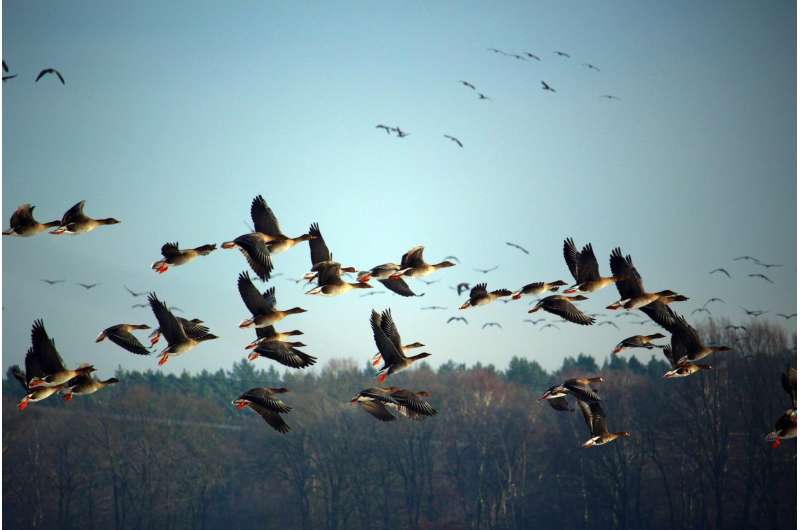Are ills of the Arctic hitting California? Hundreds of migratory seabirds wash ashore

Sara Bogard halted her dog as the two began descending the cliff down to Manchester Beach, along the Mendocino coast.
Below, scores of dead and dying birds littered the beach as far as she could see.
"The smell hit me first," said Bogard, describing the musty odor of northern fulmars scattered along the beach that mid-December morning. The smell, she recalled, was "kind of like a grandmother's closet."
What beached these offshore birds is still not known. Researchers and veterinarians who examined them—both the injured and dead—say they tended to be young and emaciated. Many had lesions on their feet, which veterinarians have identified as a papillomavirus—from the same viral family that gives humans warts but is unique to northern fulmars.
"We don't know if it's the virus that is making these birds sick, or if it's these birds' poor condition that's allowing the virus to bloom," said Rebecca Duerr, a veterinarian for the International Bird Rescue organization, which has rehab facilities in San Pedro and Fairfield.
Resembling gulls to the untrained eye, northern fulmars are a subarctic species that spend most of their life at sea. In the summer months, they congregate on rocky outcroppings in Arctic waters and the northern Bering Sea, where they breed, lay eggs and raise their young as these frigid waters teem with nutritious prey—squid, fish and crustaceans.
For the remainder of the year, the birds stay offshore—often hugging close to fishing and whaling ships—looking for food on the surface of the ocean.
Over the last half-decade, scientists have documented unprecedented die-offs of birds, marine mammals and other creatures in the northern waters where fulmars breed each year, as The Times reported in December. Researchers say the marine food web of the Arctic and sub-Arctic has been drastically altered, possibly because of climate change that has melted ice sheets and warmed the ecosystems of this vast region.
Whether this environmental shift is contributing to the strandings of young fulmars in California is unclear, said Duerr and Corinne Gibble, an environmental scientist with the California Department of Fish and Wildlife's Seabird Health Program. What is known is that the last two years have been particularly lethal for these seabirds.
In 2020, International Bird Rescue and other groups recovered 251 fulmars from the California shoreline, and 262 last year. That compares with just 44 in 2019, according to Duerr and Devin Dombrowski, with the Wildlife Rescue Medical Database.
"It's not like 2003 when more than 10,000 beached along the California coast," Duerr said. "But it's definitely more than we usually see."
In mid-January, some 28 northern fulmars could be seen convalescing at the bird rescue's facility in Fairfield, northeast of San Francisco. The distinctly scented birds floated and swam in salt water pools erected outside the facility, as rehabilitating gulls and other birds flew back and forth in a large, netted aviary nearby. One gray fulmar seemed to relish the water pouring out of an out-flow tube—swimming right up to the waterfall and then scampering aside, only to repeat.
Northern fulmars are of particular interest to ornithologists because of their longevity and biology. The average lifespan for these birds is more than 30 years, but researchers have observed birds older than 50 breeding and nesting. They mate for life and begin breeding unusually late in life for a bird, at 8 to 10 years old, producing only one egg per year. Even then, if the conditions aren't good—if there isn't enough food—they may forgo egg production.
Although often mistaken for gulls, northern fulmars have stiff wings and nostril tubes on their bills, marking them as petrels and albatrosses. While largely surface feeders, they have a powerful sense of smell and can dive 10 feet deep to find food or escape predators.
According to the U.S. Fish and Wildlife Service's most recent report of the breeding status and populations trends of Alaskan seabirds, populations of northern fulmars in the North Pacific have been generally declining or stable, with one exception: The colony on St. George's Island in the central Bering Sea appears to be growing.
But according to Kathy Kuletz, a bird expert with the Fish and Wildlife Service, it's difficult to assess the overall condition of fulmars because of limited access to their colonies in the last two years.
Because of the pandemic, the Fish and Wildlife Service conducted no fieldwork in 2020 and only a limited amount in 2021, with no report forthcoming, she said.
Although it is not yet clear that changes in the Arctic are a contributing factor, it is clear that young birds often have a harder time than adults securing the food they need. So it's not uncommon to find young, dead fulmars in the fall—as the hatchlings try, for the fist time, to find food on their own.
Just usually not this many, said Duerr, noting that stranded fulmars have been found up and down the coast this year—as far south as San Diego and Long Beach.
The good news is that 28 birds rescued by BeachWatch volunteers on Manchester Beach have survived and gained weight, she said.
Seven were healthy enough to be released recently, and Kelly Beffa and Julie Skoglund, wildlife rescuers at International Bird Rescue, drove the young birds in the back of a minivan the roughly 60 miles from Fairfield to Doran Beach in Bodega Bay.
As kayakers paddled by, and curious beach strollers stopped to watch, the bird team released the birds—two at a time—into the gentle surf. The birds skippered across the small stretch of land, before opening their wings and taking flight across the bay, toward the ocean.
"It never gets old," said Skoglund, as she watched the last two take flight toward the horizon.
©2022 Los Angeles Times.
Distributed by Tribune Content Agency, LLC.

















